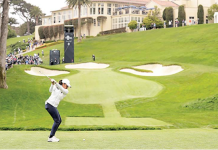By Melissa Ziobro

WEST LONG BRANCH – Imagine the biggest performing artists of the day recording their most popular hits and new compositions for members of the United States Armed Forces to enjoy – for free. Red Bank’s William J. “Count” Basie and other music legends did just that over a six-year period during and just after World War II in what was called the V-Disc program.
These records, mailed to troops around the globe from 1943 to 1949, were supposed to be destroyed following World War II but some survived. The Bruce Springsteen Archives & Center for American Music at Monmouth University (BASCAM) recently received a number of these rare original records as a gift from the family of Lt. Col. Louis C. Welch, who served for many years at nearby Fort Monmouth.
The military produced V-Discs and shipped them overseas to boost morale at a time when some servicemen and women were away from home for years at a time, risking their lives to save the world from fascism. The letter “V” in V-Disc stood for “Victory.” Included on the V-Discs were radio broadcasts from the States, live concerts and music recorded in-studio, spanning multiple genres – from big band to jazz to country, opera, church music and marches.
Some 8 million copies of over 800 unique recordings were produced during the war years and beyond, many of them at the RCA Victor facility in Camden. In fact, the first V-Discs shipped from Camden
Oct. 1, 1943.
Legends like Frank Sinatra, Bing Crosby, Duke Ellington, Lena Horne, Judy Garland, Ella Fitzgerald and many more all volunteered their services. V-Disc recordings by local star Count Basie included “The G.I. Stomp,” “The Basie Boogie,” “Jammin’ on a V-Disc,” “On the Upbeat” and many more. He recorded with his famed orchestra and partnered with other musicians to create beautifully unique music that might never have happened if not for the patriotic fervor that enveloped the whole V-Disc endeavor.
Servicemen were thrilled to have the V-Discs as they provided a musical link to home. Fan mail sent to the V-Disc unit attests to the program’s popularity. Sgt. William G. Fuss wrote, “We have been overseas for almost two years and we have not heard many popular songs. The V-Disc releases were received very gladly, as we did not have any records for about eight months. The outfit was on Guadalcanal for quite some time, and we wish to express our appreciation for the entertainment you have made possible for us.”
Another sergeant penned a note of thanks “on behalf of the boys who are listening to V-Discs over the ship’s public address system,” while another wrote from a hospital that, “I wish you could see all the happiness you have brought the boys. We can only go out in the afternoons and now for the first time you have some entertainment for the lonely evenings and mornings.”
Perhaps one of the most fantastical reports of the popularity of the V-Discs came in a December 1944 Washington Post article. “When a portable surgical hospital recently became isolated in the Burma jungle, its only supply line was by parachute. One of the first things dropped was a hand-wound phonograph and a box of records, both boogie-woogie and classical. That’s how important music has become in war.” The article quoted the hospital commandant, Maj. F. J. Sazama, as saying, “You cannot appreciate what the general feeling was. Since the machine and records arrived, it has worked constantly.”
It’s fascinating and inspiring that recording artists so enthusiastically answered Uncle Sam’s call and that music meant so much to the troops. It’s also interesting to note that it was the Armed Forces that pioneered the widespread use of vinyl for records. While vinyl records are enjoying a nostalgia-fueled renaissance today, the overwhelming majority of records in the 1940s were made of shellac. Shellac is a natural resin secreted by the lac bug, indigenous to India and Southeast Asia. It became more difficult to acquire during the war years and the supply that was available was needed for the production of critical wartime matériel like explosives, shell coatings and flares. Shellac records were also extremely fragile and not at all suitable for shipping overseas or surviving under wartime conditions. Enter vinyl, which proved far sturdier.

The press would sometimes call the vinyl V-Discs “unbreakable,” and while that was not quite true, the vinyl records were far more durable than shellac. They would become enormously popular and the music industry standard post-war.
Post-war, the V-Discs were supposed to be destroyed. Many were, but with millions out in circulation, some, inevitably, were not. Some original V-Discs stayed abroad; some were smuggled back to the United States. The mandate to destroy them – and under no circumstances reproduce them – was taken seriously. One veteran wrote to his local newspaper’s veterans’ column in 1948, asking how he could get a copy of a Glenn Miller V-Disc, only to be told, “Sorry, but the name bands made V-Disc recordings for free, with the understanding that they would not be released through commercial channels.” Authorities confiscated copies for years.
Welch’s family isn’t sure how the lieutenant colonel held on to his records, but BSACAM staff said they are thrilled to have the nine unique pieces of American music history added to the collection. The Welch V-Discs include recordings by Duke Ellington, Harry James, the Boston Port of Embarkation Band and Count Basie.
By the 1990s, reproductions of some V-Disc recordings were being compiled and sold on cassette and then compact disc, when complicated permissions could be worked out. Today, the curious can stream a lot of V-Disc music and even find some original V-Discs on eBay. The Library of Congress has assembled and preserved a full collection. The BSACAM’s new museum, scheduled to open in spring 2026, will have a dedicated V-Disc exhibit. For more information about BSACAM, visit springsteenarchives.org.
Melissa Ziobro is the curator of the Bruce Springsteen Archives & Center for American Music, and director of Public History, at Monmouth University.
This article originally appeared in the January 11 – 17, 2024 print edition of The Two River Times.















